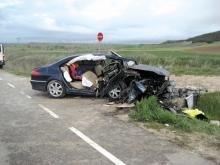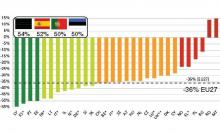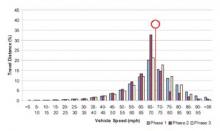
ASECAP and its members are among many oragnisations leading the fight to improve road safety
Many European organisations have pledged their support to the goal of dramatically reducing even further the number of accidents, fatalities and serious injuries on roads.And at its annual road safety conference in the Czech capital Prague,
Stakeholders were invited to discuss the forthcoming EU Road Safety Action Programme, as well as to appreciate the best and most innovative practices in terms of motorways management.
Of all modes of transport, transport by road is the most dangerous and the most costly in terms of human lives. For this reason, the Road Safety Action Programme (2003-2010) proposed a series of measures such as stepping up checks on road traffic, deploying new road safety technologies, improving road infrastructure and measures to improve users' behaviour. The ultimate objective is to halve the number of people killed on the roads by 2010. A new road safety programme is scheduled for 2011-2020.
At the ASECAP gathering, many members (tolled motorways concessionaires) said they have fully met the 50% road fatalities reduction target set by the
The conference was also the occasion for the main actors to discuss the upcoming 4th European Road Safety Action Programme.
Delegates heard that significant achievements in road safety are the result of the best engineering practices in terms of research, design, maintenance, operation, and were made possible on tolled road network and under PPP (public private partnership) schemes, where the collected revenues are directly earmarked in order to make road infrastructures safer, greener and smarter.
Enrico Grillo-Pasquarelli, the EU Director for Inland Transport of the new DG MOVE (formerly DG TREN) praised the role played by the concessionaires' sector and by ASECAP.
He then presented the main drivers behind the 4th Road Safety Action Programme that will be launched in May.
The focus of the future EU strategy will be set on the weakest elements of the safety chain: users' behaviour (education and training); vulnerable users, secondary networks, enforcement of existing rules, and on the improvement of the situation in less-performing Member States.M. Kaas, Deputy Minister for Transport of the Czech Republic, highlighted the importance of the future EU strategy and informed the participants on his country's ambitious safety programme that pays particular attention to prevention, both in terms of supervision of the design and engineering phases, and on education to the users and information campaigns.
Reiterating ASECAP's strong support to the European Commission's action, K. Dionelis, ASECAP Secretary General, underlined the need to develop reliable statistics, common definitions and sound data collection mechanisms. He called on the EU executive to address the right objectives and set a particular focus on inappropriate users' behaviour, secondary roads and on the urban dimension, where most of the accidents occur.
In this perspective, ASECAP says it is ready to share its expertise and put the experience of its members at the service of the European institutions and citizens, "thus contributing to saving even more lives in the decade to come." Meanwhile, ASECAP is preparing for 38th Study and Information Days, which will be held in Oslo, Norway from 30 May-2 June.
Speeding: still a problem
The European Transport Safety Council (ETSC) also held a conference, Future Directions in Speed Management, which highlighted how excessive or inappropriate speed has a singularly devastating impact on health and safety of road users, increasing both the risk of a crash and the severity of crash outcomes.
It is estimated that speeding contributes to as much as one-third of all crashes resulting in death, and it is the most important contributory factor to road deaths and injuries.
Therefore tackling speed must form a central part of the EU's forthcoming Road Safety Action Programme, says the ETSC.
New ambitious targets and strong measures to reduce road death and serious injury by 2020 are expected in the new programme by the road safety community when it is published.
"Trends in driving speeds show that overall there is little progress in Europe. Average speeds and speed limit violations remain high with encouraging signs only in a few countries.
"In most societies speeding is still considered more socially acceptable than drink-driving, and the risk posed by so-called 'minor speeding' is also grossly underestimated: in fact it is estimated that at any one moment about 35% of drivers exceed speed limits outside built-up areas and as much as 50% in urban areas. The fact that speeding is so common poses a very significant threat to safety," says ETSC.
And it points to numerous measures that can help manage speed: action can be taken in all of the road safety pillars.
New measures that ETSC hopes will be adopted in the framework of the upcoming 4th Road Safety Action Programme should include, for example, as a matter of priority, guidance to Member States to tackle traffic law enforcement of speed as well as a new Cross Border Enforcement Directive.
The in-vehicle Intelligent Speed Assistance (ISA) technology and supporting digital speed maps should also be developed, as well as EU guidelines to reduce speed via traffic calming measures.
Experts were invited to demonstrate how each element of the road transport system can be improved to tackle speed.
Ian Aspinall, business manager, Association of Chief Police Officers of England, Wales and Northern Ireland (ACPO), spoke about the National Driver Offender Retraining Scheme that has successfully been implemented in the UK, with clear evidence that after attending the scheme offenders have safer and more responsible attitudes towards road user behaviour than before.
Professor Oliver Carsten, a professor of transport safety, spoke about the safety potential that can be attained with the deployment of ISA systems, a technology that lets vehicles "know" the speed limit of the roads on which they are driven, and inform the driver or act upon the driving task to facilitate compliance with speed limits.
Prof Fred Wegman, professor of Road Safety at Delft University of Technology, Holland, spoke about the infrastructure improvements that can be made to help drivers behave safely, as embodied by the Dutch sustainable safety approach.









